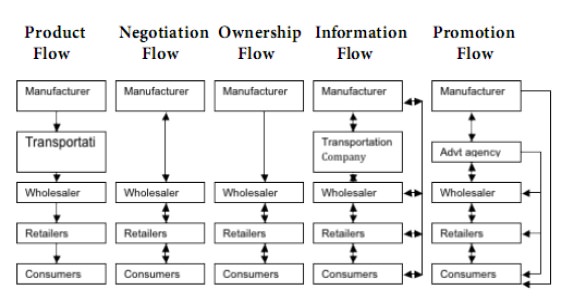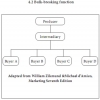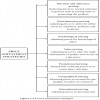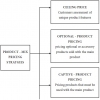MARKETING MANAGEMENT - Marketing Channels
Flows In Marketing Channels - Marketing Channels
Posted On :
As discussed a conventional channel of distribution consist of a manufacturer, a wholesaler, a retailer and the ultimate consumer.
Flows In Marketing Channels
As discussed a conventional channel of distribution consist of a manufacturer, a wholesaler, a retailer and the ultimate consumer. Not all the channels include all these marketing institutions. At times the product passes directly from the manufacturer to consumer. When a marketing channel has been developed a series of flows emerge. These flows provide the links that tie channel members and other agencies together in the distribution of goods and services. There are five most important flows namely
1. Product flow
2. Negotiation flow
3. Ownership flow
4. Information flow
5. Promotion flow
Product Flow Negotiation Flow Ownership Flow Information Flow Promotion Flow

The orgin and concept of flows in marketing channels is generally attributed to Ronald S. Valie, E.T Grether and Reavis Cox
As discussed a conventional channel of distribution consist of a manufacturer, a wholesaler, a retailer and the ultimate consumer. Not all the channels include all these marketing institutions. At times the product passes directly from the manufacturer to consumer. When a marketing channel has been developed a series of flows emerge. These flows provide the links that tie channel members and other agencies together in the distribution of goods and services. There are five most important flows namely
1. Product flow
2. Negotiation flow
3. Ownership flow
4. Information flow
5. Promotion flow
Flows in the Marketing channel
Product Flow Negotiation Flow Ownership Flow Information Flow Promotion Flow

The orgin and concept of flows in marketing channels is generally attributed to Ronald S. Valie, E.T Grether and Reavis Cox
The Product flow refers to actual physical movement of the product from
the manufacturers through all the parties who take physical possessions of the
product from the point of production to the final consumer.
In the negotiation flow, this represents the interplay of the buying and the selling functions associated with the transfer of title.
If you note the diagram you find the transportation firm is not included in the flow because it does not participate in the negotiation function, also you can find the arrows flow in both the directions, indicating the negotiation is mutual at all levels of the channels. The ownership flow shows the movement of the title to the product as it is passed along from the manufacturer to the consumer, here as well we find the transportation function missing since the transportation firm does not take title or is actively involved in the facilitating function. It merely involves in transporting physical products
In case of the Information flow, we can see that the transportation function has reappeared and all the arrows are two-directional. All the parties participate in the exchange of information. For example Coke may obtain information from the transportation company about its shipping schedules and the rates, while the transportation firm may seek information regarding when and in what quantities it plans to ship its products. Some times the information bypasses the transportation company directly to the wholesaler or the retailer when the information does not concern the transportation firm. If there is an offer, or a price reduction these information are not needed by the transportation firms.
Finally the Promotion flow refers to the persuasive communication in the form of advertising, personal selling, publicity. There is a new component that is added to the flow and that is the advertising agency and this actively provides and maintains the information flow. The organizations work closely with the promotional organizations so we find a two-directional arrow.
From the management view, the concept of channel flows provides a useful framework for understanding the scope and complexity of channel management. Changing scenario does make the role of the firms’ complex,
In the negotiation flow, this represents the interplay of the buying and the selling functions associated with the transfer of title.
If you note the diagram you find the transportation firm is not included in the flow because it does not participate in the negotiation function, also you can find the arrows flow in both the directions, indicating the negotiation is mutual at all levels of the channels. The ownership flow shows the movement of the title to the product as it is passed along from the manufacturer to the consumer, here as well we find the transportation function missing since the transportation firm does not take title or is actively involved in the facilitating function. It merely involves in transporting physical products
In case of the Information flow, we can see that the transportation function has reappeared and all the arrows are two-directional. All the parties participate in the exchange of information. For example Coke may obtain information from the transportation company about its shipping schedules and the rates, while the transportation firm may seek information regarding when and in what quantities it plans to ship its products. Some times the information bypasses the transportation company directly to the wholesaler or the retailer when the information does not concern the transportation firm. If there is an offer, or a price reduction these information are not needed by the transportation firms.
Finally the Promotion flow refers to the persuasive communication in the form of advertising, personal selling, publicity. There is a new component that is added to the flow and that is the advertising agency and this actively provides and maintains the information flow. The organizations work closely with the promotional organizations so we find a two-directional arrow.
From the management view, the concept of channel flows provides a useful framework for understanding the scope and complexity of channel management. Changing scenario does make the role of the firms’ complex,
Tags : MARKETING MANAGEMENT - Marketing Channels
Last 30 days 7555 views















